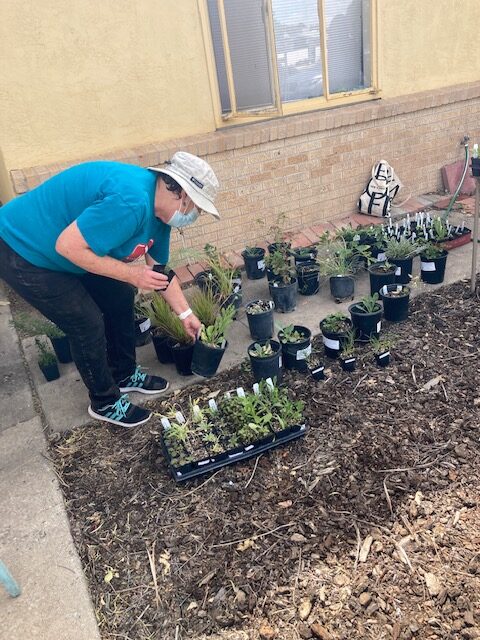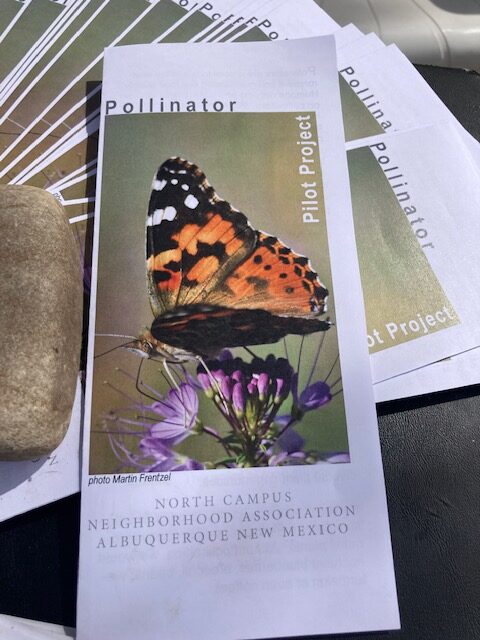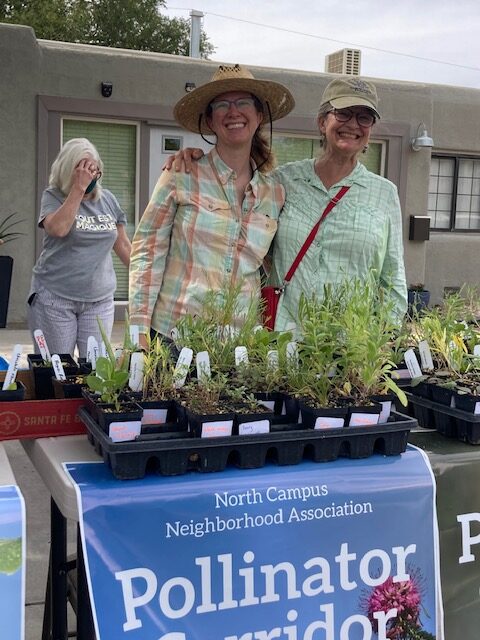Creating Neighborhood Pollinator Smorgasbords
Guest blog by Anita Amstutz, Board member of the New Mexico Beekeepers Association, successful in passing the Burque Bee City USA Resolution. Anita also founded the non-profit, Think Like a Bee, a pollinator education and advocacy organization.
There are food deserts for pollinators in the Albuquerque neighborhoods. Because plants require water, it can be a long slow process to keep them alive for a season in the high desert. Climate change is also bringing more unpredictable weather patterns and aridification. Summers are longer and hotter, with less rainfall or other moisture; winters are also drier.
The main impacts on bee populations, including native bees and domestic honey bees, are:
- earlier leaf-out of all plants;
- cold snaps which freeze flowering trees, including fruit trees, as bees begin to forage in the spring; and
- plant communities being altered, moving, or disappearing altogether.
Since its establishment in 2016, Albuquerque’s Bee City USA committee—referred to locally as Burque Bee City USA—has been mitigating global climate change and its ravaging impact on bee food sources and habitat by working with the human “hive mind”! We are building islands of pollinator plants in our neighborhoods around the city.
The Burque Bee City USA resolution, unanimously passed by Albuquerque City Council in 2016, states:
Whereas communities have the opportunity to support bees and other pollinators on both public and private land through reduced and pesticide free zones: working in collaboration with city officials to manage and increase healthy habitat for pollinators—including but not limited to roadsides, medians, open spaces and parks.
CITY OF ALBUQUERQUE, 22nd city council, Burque Bee City Resolution
It took a retired nurse and Master Gardener to fulfill this goal! Noticing that her neighborhood beekeeper no longer brought her an annual jar of honey, Terry Dettweiler asked what happened? The beekeeper said she had hung up her beekeeping veil when she could no longer keep the honey bee hives alive. Terry then noted a dreary lack of pollinator plants in the neighborhood.
Terry’s knowledge of native plants and growing love of bees, coupled with the loss of her honey source, motivated her to begin raising money and orchestrating free native pollinator plant giveaways in the spring and fall of 2021. Enthusiasm abounded amongst the neighborhood association. Community members worked hard to organize, set up, and be present on the giveaway days. The first plant giveaway happened in May. The spring giveaway was smaller than the fall event, since organizers were still awaiting funding from the city councilors. The fall plant giveaway was greatly boosted by the Santa Ana Pueblo and their wholesale greenhouse. They were able to supply over one thousand drought tolerant, native Southwest plants for the event. The weekend of September 21 and 22 dawned in Albuquerque with the usual blue skies and autumnal sunshine bathing the city. People showed up carrying buckets, with dogs on leashes, partners pulling wagons, and parents pushing children in strollers. Attendees hauled away armloads and boxes of coral penstemon, indigo sage, catmint, multitudes of grasses, endless chocolate flowers, echinacea, gaillardia, flowering bushes, and more…
-

Neighborhood Master Gardeners helped with plant information. -

Neighbors choosing plants. -

A visitor examining available plants.
Teachers came eager to bring plants back for their schools and students. Between 500 and 700 plants went out the door on both Saturday and Sunday. The buzz was out! It became clear that our community cares about the pollinators that we share our landscape with and is excited to learn more about native plants and their role in supporting bees and other invertebrates.
Tables were also laden with materials sharing information about how to water your plants and nurture them for the first year—so their roots grow strong. There were flyers for native plants, xeric landscapes, and backyard wildlife refuges. Think Like a Bee, an Albuquerque-based organization for community pollinator education and advocacy, was available to answer any questions alongside Master Naturalists and Master Gardeners. One of our supportive County Commissioners, Adriann Barboa, joined in the celebratory atmosphere, excited about how this project met so many of her own urban agriculture goals. Commissioner Barboa’s goals for the community include forming connections between neighbors, populating landscapes with native plants for bee oases, and collaborating with Indigenous communities to grow native plants.
-

Flyers about this pilot project were available. -

Albuquerque neighborhood association plant giveaway. -

Terry Detweiler and her daughter Eva.
This coming spring, we will take the template that Terry created and involve more city neighborhoods—educating people about bees, and giving away free low-water, xeric, and nutritious native pollinator plants.
This neighborhood experiment shows us a way forward. This model will help us build complex networks of support between species—including humans and the plants and insects with which we share the world—as we foster resilient landscapes in the face of a changing climate.





